Hey there, fellow Bull Terrier enthusiasts!
If you’re as captivated by this lively and muscular breed as we at Breed Atlas are, you’re probably keen to ensure your adorable puppy grows up to be a healthy and happy adult.
Well then, get a load of this Bull Terrier growth chart – your go-to resource for understanding the key growth stages of your pup.
Bull Terrier Growth Chart Overview
Bull Terriers are a robust and energetic breed known for their distinctive egg-shaped head and muscular build.
Raising such a unique pup is an exciting journey for new pet parents. It is filled with playful moments and important milestones that these strong pups achieve.
From the moment you bring your adorable puppy home, through their rapid growth phases, to their dignified adult years, monitoring their development is more than necessary.
Our following weight chart provides you with a clear picture of how your Bull Terrier should be progressing.
| Age (Months) | Male Weight (lbs) | Male Height (inches) | Female Weight (lbs) | Female Height (inches) |
| Birth | 10-15 oz | – | 10-15 oz | – |
| 1 | 4-7 lbs | 4-5 inches | 3-6 lbs | 3.5-4.5 inches |
| 2 | 10-15 lbs | 7-9 inches | 8-12 lbs | 6.5-8 inches |
| 3 | 20-25 lbs | 10-12 inches | 18-22 lbs | 9-11 inches |
| 4 | 25-35 lbs | 12-14 inches | 22-30 lbs | 11-13 inches |
| 5 | 30-40 lbs | 14-16 inches | 25-35 lbs | 13-15 inches |
| 6 | 35-45 lbs | 16-18 inches | 30-40 lbs | 14-16 inches |
| 9 | 45-55 lbs | 18-20 inches | 35-45 lbs | 16-18 inches |
| 12 | 50-70 lbs | 19-21 inches | 40-55 lbs | 17-19 inches |
| 18 | 55-75 lbs | 20-22 inches | 45-60 lbs | 18-20 inches |
Although this Bull Terrier growth chart offers a more accurate estimate of their adult size and weight, it is still an estimate.
So, if your Bull Terrier doesn’t exactly match the weights and heights listed here, don’t stress!
Use this chart as a helpful guide, but always consult with your veterinarian to ensure your pup is growing healthily.
Bull Terrier Puppy Key Growth Stages

Your Bull Terrier’s transformation from a cute and cuddly puppy to a graceful and dignified adult comes with lots of ups and downs. Therefore, it is important to understand their growth patterns.
This way, you can easily give your Bull Terrier the best chance at life!
Let’s dive into what you can expect during these crucial periods, starting with the birth to 3 months stage.
Birth To 3 Months

From the moment your Bull Terrier puppy is born, they are a delicate and tiny bundle of joy, weighing just around 10-15 ounces.
One of the sweetest things about this stage is watching them sleep.
Newborn puppies spend most of their time dreaming, which plays a significant role in their brain development.
It’s fascinating to observe their tiny twitches and movements as they dream about who-knows-what – probably about all the adventures they’ll have with you!
As your puppy reaches the 1-month mark, you’ll start to see some significant changes.
Their lil’ eyes and ears open, and they begin to take in the world around them. They’ll start to become more active, wobbling around on their little legs and exploring their immediate environment.
This is also the time when they begin to wean off their mother’s milk and start eating new food (puppy mush).
During these early months, your Bull Terrier will experience rapid growth. They typically weigh between 10-15 lbs by the end of the second month and 20-25 lbs by the end of the third month.
Remember to stay on top of vaccinations and preventative care to protect them from common health conditions. Trust me, this will ensure fast and healthy growth!
3 To 6 Months
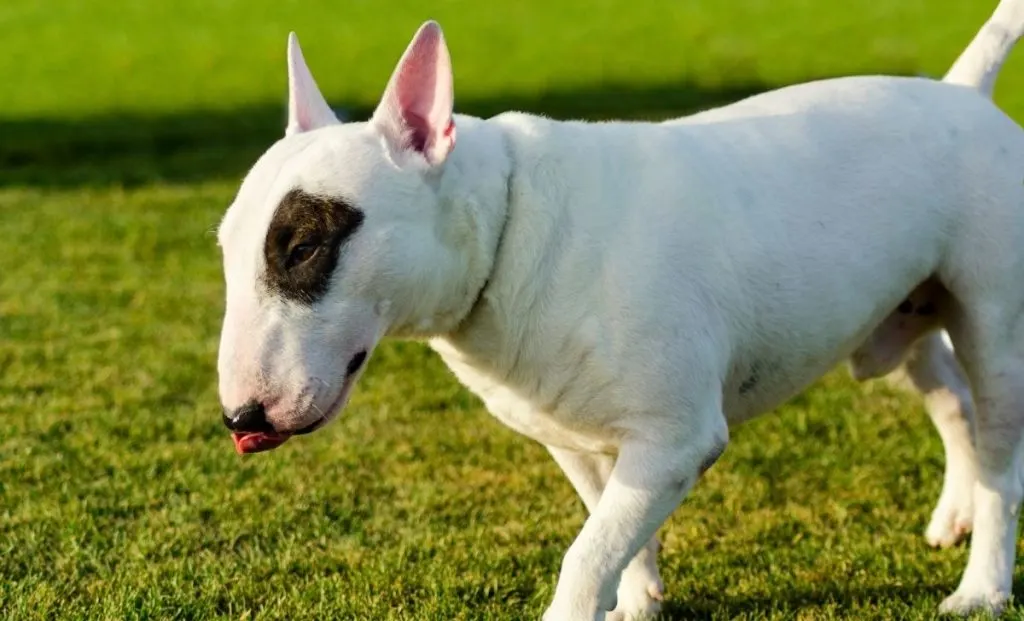
Between 3 to 4 months, your Bull Terrier puppy will continue to grow rapidly. They usually weigh around 20-25 pounds at the beginning of this period and can reach up to 35 pounds by the end of the fourth month.
By 5 to 6 months, your Bull Terrier will likely weigh between 35-45 pounds. They’ll have reached a significant portion of their adult size, but they aren’t done growing yet.
Most Bull Terriers reach the majority of height by 6 months, but their weight might continue to increase as they fill out and gain muscle.
Proper nutrition is super important right now. Your playful puppy should be munching on high-quality puppy food that’s specifically formulated for their needs.
A balanced diet packed with nutrients supports their fast growth and helps them develop strong bones and muscles.
This is a prime time for training. Consistent, positive reinforcement methods work wonders. Focus on basic commands, house training, and leash training.
Socializing with other dogs, especially breeds like Staffordshire Bull Terriers or other terrier breeds, can be very beneficial. They’ll learn good behaviors and get used to different types of dogs.
Regular vet check-ups help with the early detection of potential health issues. Conditions like kidney issues can sometimes be detected early with routine screenings.
Additionally, early detection of issues like hip dysplasia or patellar luxation can make a significant difference.
This period is also a good time to discuss genetics and potential inherited health issues with your veterinarian.
There is a genetically determined metabolic disease called lethal acrodermatitis that is observed in Bull Terriers. This condition is characterized by growth retardation, chronic skin infections, and immune system deficiencies. Affected puppies often show stunted growth and have a median survival time of 7 months (1).
Understanding your Bull Terrier’s genetic background can help in managing and preventing certain conditions.
6 To 12 Months
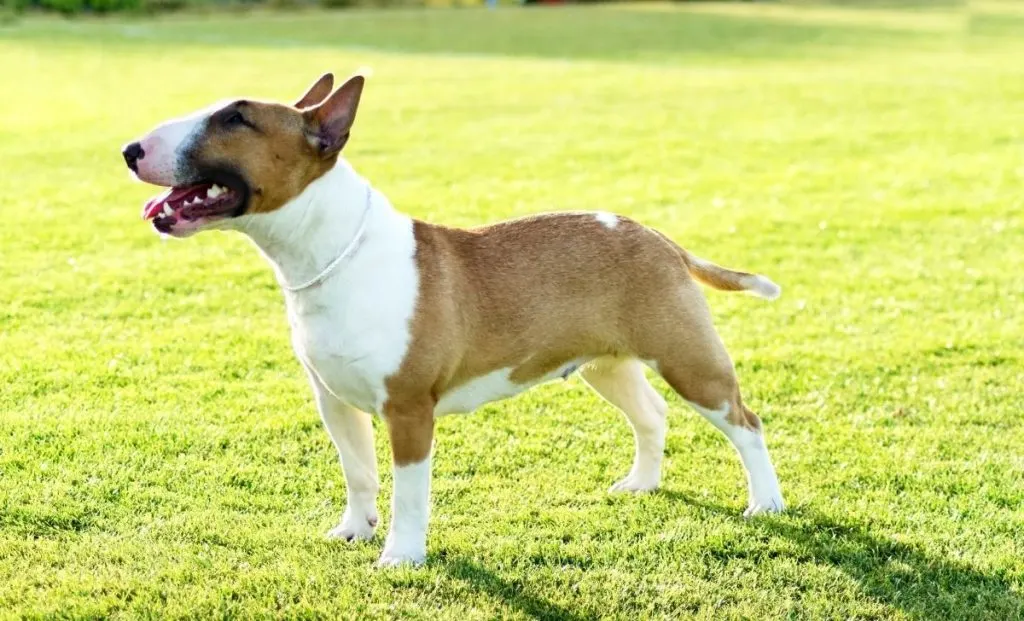
At six months old, your Bull Terrier is likely around 35-45 pounds and still growing. By the time they hit the 12-month mark, they can weigh between 50-70 pounds.
It’s fascinating to watch them fill out and gain muscle, showing signs of their strong, athletic build. They are also approaching their adult height!
During this phase, maintaining a balanced diet is crucial. As their growth rate slows, their nutritional needs will adjust, so transitioning to high-quality adult dog food is important.
Look for food that supports joint health and muscle development to help them grow into their full potential.
Apart from quality dog food, adequate portions are important too. Regular dog’s weighings will help in adjusting food portions correctly.
Your Bull Terrier will also exhibit more mature behavior, but don’t be surprised if their playful puppy side still shines through. Regular exercise is vital to keep them healthy and happy.
By now, your Bull Terrier should be well into their training routine. Training is one of the important ways to ensure they develop good habits and mental sharpness.
So, reinforce basic commands and introduce more advanced training to keep their minds sharp.
Maintaining an active lifestyle is crucial for their overall well-being.
Everything is possible with a Bull Terrier! So consider various activities like hunting, dog sports, police work, and agility training.
Regular vet visits remain essential.
12 To 18 Months
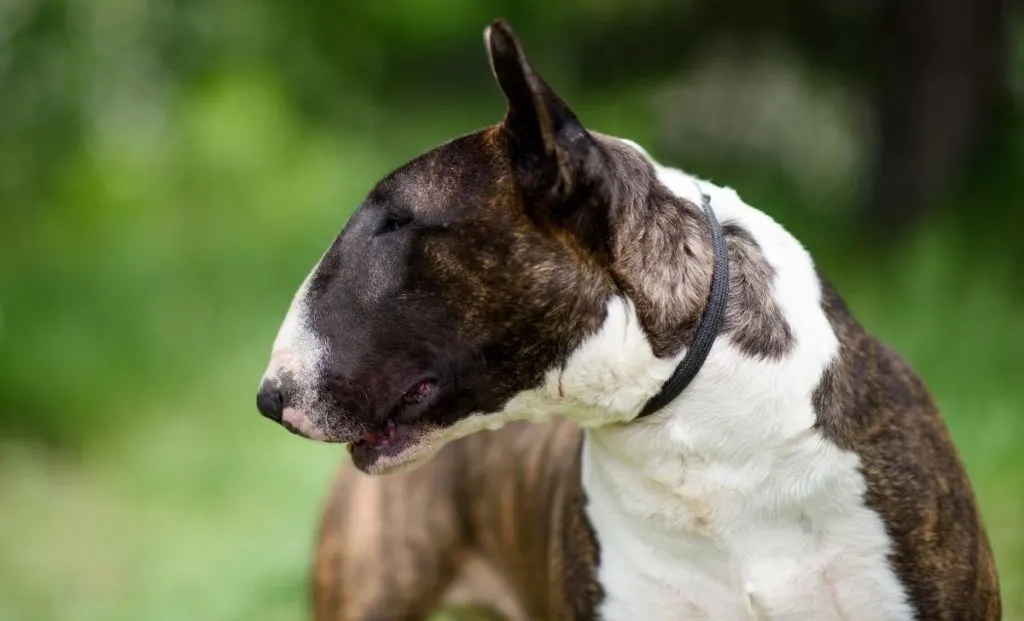
Now that your pup is entering the 12 to 18 months stage, they’re well on their way to becoming the strong, confident dog you’ve been nurturing.
This period is crucial for their final growth spurts, mental maturity, and solidifying their adult behavior.
By now, your Bull Terrier is nearing their full adult size. They might still fill out a bit more, gaining muscle and bulk. Typically, they’ll weigh between 55-75 pounds and stand about 20-22 inches tall.
Monitoring their adult weight with a weight chart helps ensure they’re growing healthily and maintaining an optimal weight.
So, go easy on the treats! They no longer need the high-calorie, nutrient-dense puppy food. Instead, transition them fully to high-quality adult dog food that supports their active lifestyle.
And yes, your all grown-up Bull Terrier will have plenty of energy. This will require consistent exercise to stay fit and healthy.
Long walks, playtime, and agility training are excellent ways to keep them engaged. This period is perfect for reinforcing good habits and ensuring they don’t develop destructive behaviors out of boredom.
By the end of 18 months, your Bull Terrier will be a well-rounded, mature dog ready to enjoy their vibrant life to the fullest.
Ensuring your Bull Terrier’s health through regular vet visits, vaccinations, and preventative treatments (like flea and tick prevention) remains vital.
Pro Tip: If you haven’t by now, consider pet insurance. It can save you from unexpected vet bills and ensure your pup gets the best care possible! So, try to find some good pet insurance companies in your area.
At What Age Is A Bull Terrier Full Grown?
Bull Terriers typically reach their full size between 12 to 18 months. By this age, they usually hit their adult weight and height, although they might continue to fill out a bit more as they gain muscle and mature fully.
When it comes to growth and development, Bull Terriers share some similarities with breeds like Pit Bulls, Staffordshire Bull Terriers, and other terrier breeds.
For instance, Pit Bulls and Staffordshire Bull Terriers also experience rapid growth during their early months and have similar adult sizes.
However, each breed has its unique growth patterns and health considerations.
How Big Will My Bull Terrier Be?
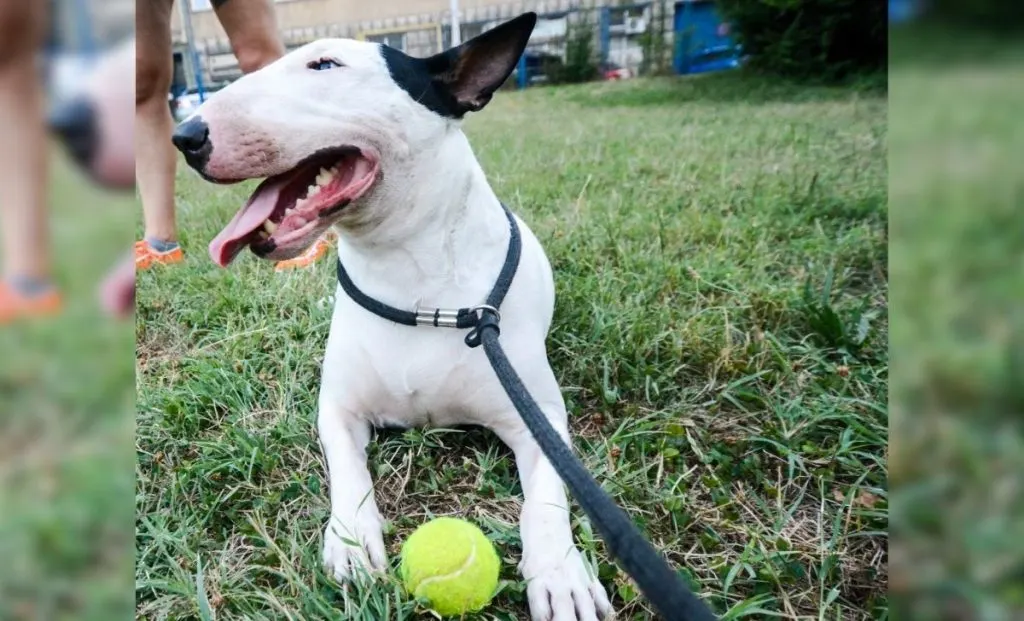
It’s important to keep in mind that Bull Terriers are typically medium-sized dogs, and their size can vary slightly between males and females.
When comparing the growth of Bull Terrier females to their male counterparts, there are a few key differences to keep in mind.
According to the official AKC breed standards, both inherit a body that is well-rounded with a deep chest, strong back, and muscular build.
Generally, male Bull Terriers tend to be slightly larger and heavier than females. They typically weigh between 55-75 pounds and stand about 20-22 inches tall.
Adult female Bull Terriers usually weigh a bit less, ranging from 45-65 pounds, and they stand slightly shorter, around 18-20 inches tall.
These differences in size are due to natural variations in the breed’s growth patterns and genetics.
What Is The Life Expectancy Of A Bull Terrier?
You might know that smaller dogs often outlive their larger counterparts, but even though Bull Terriers fall into the medium-sized category, they still enjoy a relatively long life.
On average, these delightful pups live around 10 to 14 years. Not too shabby, right?
This is a bit of a bonus for us Bull Terrier fans, as we get to enjoy their goofy personalities and loyal companionship for many years.
5 Factors Affecting Bull Terrier Growth

Watching your Bull Terrier grow from a playful puppy into a strong, confident adult is an exciting time that is filled with wonder and a few questions along the way.
What makes your Bull Terrier grow the way they do?
Let’s dive into some important factors that influence their growth.
1. Genetics
First up, genetics play a major role in determining the size, weight, and overall growth pattern of your Bull Terrier.
Just like with humans, the genes inherited from their parents set the foundation for their physical traits.
If your Bull Terrier’s parents were on the larger side, chances are your pup will follow a similar growth trajectory.
Breeding practices and the genetic health of the lineage can also affect growth rates and the final size of your Bull Terrier. They also determine what color your Bull Terrier will be.
In any case, make sure to always seek for reputable Bull Terrier breeders.
2. Nutrition
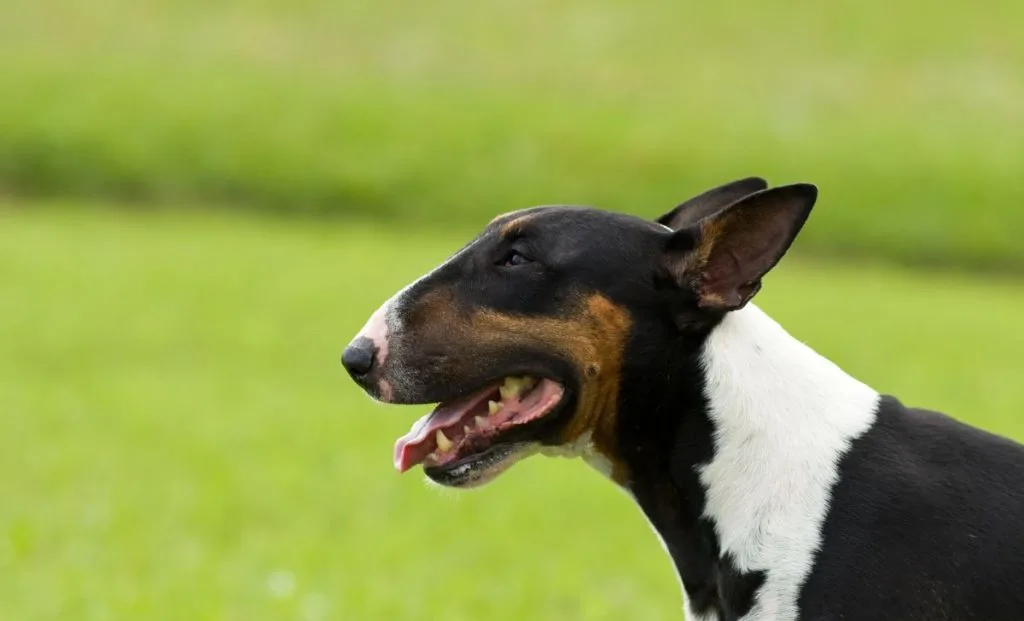
As you may have guessed, nutrition plays a critical role in your Bull Terrier’s growth and development.
Feeding your puppy high-quality food that’s specifically formulated for their needs ensures they get all the essential nutrients required for healthy growth.
Proper nutrition not only fuels their growth but also helps prevent health issues that usually occur in their senior years, like obesity and joint problems.
So, choosing the right food for each stage of their life is super important.
Keep in mind that a well-fed Bull Terrier is a happy, healthy Bull Terrier, ready to take on the world!
3. Neutering/Spaying
The timing of neutering or spaying can significantly impact your Bull Terrier’s growth.
Here’s an intriguing tidbit for you: did you know that growth plate closure and skeletal maturity are significantly delayed in neutered dogs, especially those neutered at a younger age?
This extended growth period can result in larger final skeletal dimensions. Essentially, if a dog is neutered before their growth plates close, their bones continue to grow for a longer period, leading to a taller and larger adult size (2).
This extended growth is because the hormones that are removed during neutering play a critical role in signaling the growth plates to close.
Without these hormones, the growth plates stay open longer, and the bones keep growing.
This study is indeed interesting, but it’s also worth noting that it is quite old. If you are interested in this topic, it may be useful to research more about it.
However, in every possible case, if you’re planning to neuter your Bull Terrier, it’s worth discussing the timing with your veterinarian to understand how it might affect their growth and development.
4. Environmental Factors
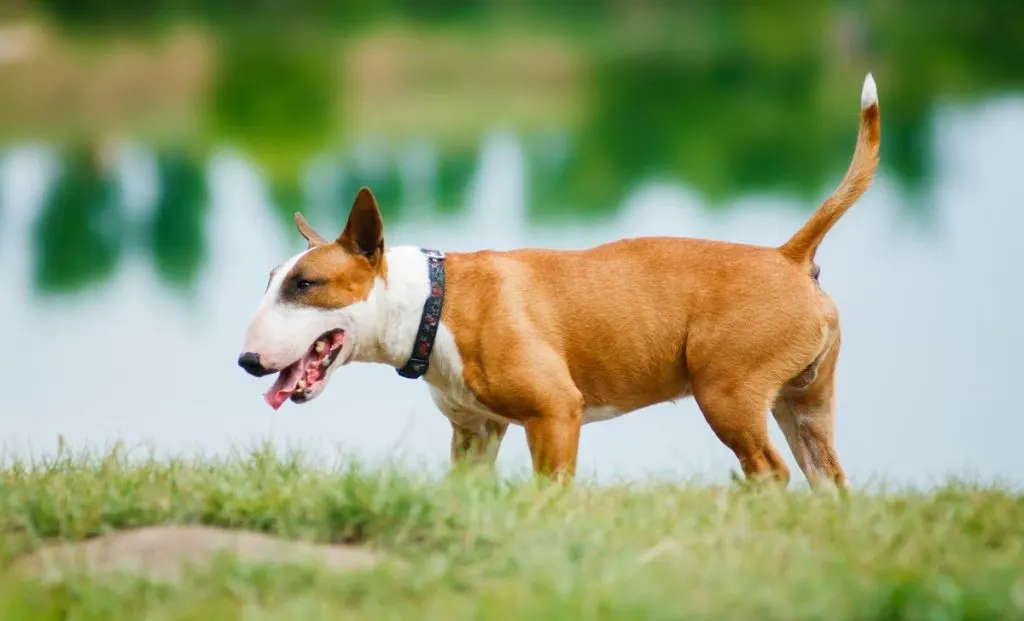
Did you know that your Bull Terrier’s environment plays a massive role in their growth and development? It’s true!
Factors like living space, climate, and social interactions are all super important.
Providing a safe, stimulating, and supportive environment helps your Bull Terrier explore, exercise, and grow without any undue stress.
Your playful puppy should be happily romping around, discovering new scents and sights – that’s the goal!
It is shown that social interactions with other dogs and humans are essential for their emotional well-being. This directly impacts their physical health and growth.
Proper socialization from a young age leads to well-adjusted adult dogs with fewer undesirable behaviors and stronger bonds with their owners (3).
This fascinating study that shows well-socialized dogs tend to be more adaptable, confident, and happy.
Sounds like a dream, right?
5. Health and Veterinary Care
Vet visits are crucial for vaccinations, deworming, and preventative care, ensuring your Bull Terrier grows up strong and healthy.
Spotting growth-related health concerns like hip dysplasia or patellar luxation early on means you can tackle them head-on with timely intervention and management.
Consistent veterinary care helps keep them on track and addresses any concerns that might pop up during their development.
So, as a vet, I highly recommend that you gear up for those vet visits and let your pup enjoy a happy, healthy journey!
Remember to use the Bull Terrier growth chart to keep track of your pup’s development and make sure they’re on the right path to a healthy, happy life!
References
1. Jezyk, P., Haskins, M., MacKay-Smith, W., & Patterson, D. (1986). Lethal acrodermatitis in bull terriers.. Journal of the American Veterinary Medical Association, 188 8, 833-9 .
2. Salmeri, K., Bloomberg, M., Scruggs, S., & Shille, V. (1991). Gonadectomy in immature dogs: effects on skeletal, physical, and behavioral development.. Journal of the American Veterinary Medical Association, 1987, 1193-203 . https://doi.org/10.2460/javma.1991.198.07.1193. 3. Howell, T., King, T., & Bennett, P. (2015). Puppy parties and beyond: the role of early age socialization practices on adult dog behavior. Veterinary Medicine : Research and Reports, 6, 143 – 153. https://doi.org/10.2147/VMRR.S62081.

Meet Iram, a devoted veterinarian, passionate dog lover, and current Ph.D. candidate at Utrecht University in the Netherlands. Seamlessly blending her roles as a vet and content writer, Iram channels her love for dogs into heartfelt narratives.
Since childhood, Iram nurtured a dream of becoming a vet, a passion that runs deep in her family. Having now fulfilled that dream, she’s eager to share her acquired knowledge. In her writing, Iram not only explores the emotional bond between humans and their canine friends but also integrates her veterinary expertise, offering readers a holistic understanding of their beloved pets.
